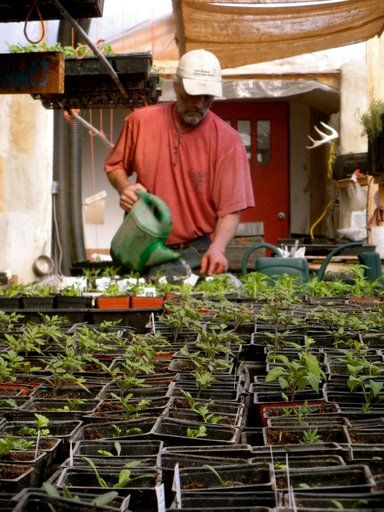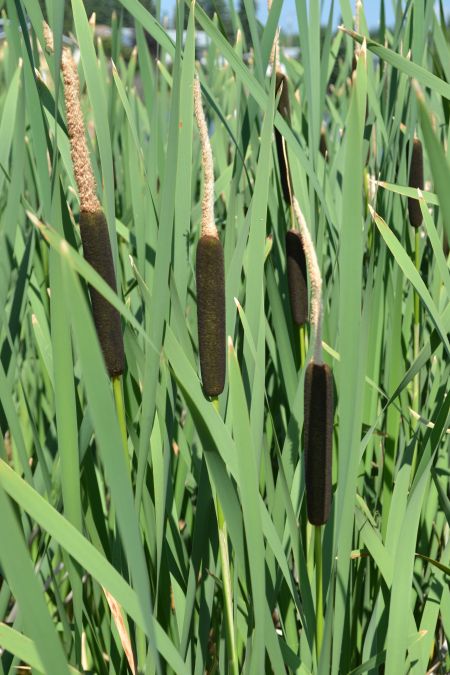ROBLIN, MB—For nearly two decades, David Neufeld and his partner, Maggie Andres, have grown organic bedding plants in their greenhouse near Boissevain in southwestern Manitoba. Their farm, "Room to Grow," is set amid rolling hills known locally as the Turtle Mountains.
Today the farm has become a reference point for farmers and other residents dealing with the impacts of potent herbicide application by rural municipalities. Despite conflicting federal instructions, Manitoba continues to wage a war on weeds. While the province considers toughening legislation in order to enforce local weed control programs, Neufeld and Andres are speaking out against the current policies and practices.
The couple’s background in the Mennonite Church instilled in them a strong sense of public service and sustainable living. They settled with their children in Manitoba in the early 1990s.
There, they became the first and only producers in the province at the time to market certified organic seedlings, such as tomatoes, peppers and medicinal herbs, to fellow growers. Over the years, their rural homestead became a gathering point for others who shared their passion for a simpler way of living.
While no longer officially certified as organic, the two were still producing their plants without the use of chemicals when tragedy struck in 2010. To their horror, as Neufeld put it, “Every single one of our plants curled up grotesquely and died!” He estimates this resulted in a revenue loss of $10,000.
They sent samples to a Winnipeg lab, which confirmed that the culprit was a potent weed killer, Tordon 101. With two active ingredients—picloram and 2,4-D—Tordon 101's deadly nature has been known for over half a century. It is made by agricultural industry giant Dow AgroSciences Canada. Dubbed “Agent White,” the US military applied it, along with its infamous cousin “Agent Orange,” on the jungles during the Vietnam war in the 1960s.
The couple was unaware that their local government, the Rural Municipality (RM) of Morton, had in 2008 sprayed ditches near their home with the chemical. Neufeld mowed hay in those ditches to feed their horses and then used the composted manure to fertilize the greenhouse plants.
After losing all their plants, they were able to restore their business, but only after removing and replacing the contaminated soil from their greenhouse.
Since his RM has continued to spray the same chemical along the roadways, the couple can no longer cut the hay there. They now pay for it elsewhere at added expense.
But Neufeld blames himself, not his local government, for what happened. And he doesn’t expect to be reimbursed for the couple's financial losses. He had habitually checked with the RM to ensure it had not been spraying, he told The Dominion. But in 2008, when that fateful spray application is believed to have occurred, he neglected to do so. And he is far from the only farmer dealing with the impact of Tordon 101 in Manitoba.
Since the province's birth 142 years ago, Manitoba has been waging a war on weeds. Weapons in its arsenal include a sweeping piece of legislation called The Noxious Weeds Act and potent weed killers with unsettling safety records. Manitoba is not alone in this, either. Similar legislation is found in provinces and states throughout North America.
Powerful herbicides became a significant tool in Manitoba’s “war” as early as the 1930s. According to the Manitoba Weed Supervisors Association, that’s when they began ordering these products in bulk.
A key element in the province's crusade has been the spraying of public rights-of-way, including ditches along rural roads. According to the government, this is to prevent the weeds from spreading into farmers’ fields.
Tordon 101, the formulation that killed Neufeld’s bedding plants, is no stranger to controversy. As long ago as the 1950s and 60s, it was used as a defoliant in New Brunswick, together with its companion, “Agent Orange,” along power lines and at the Camp Gagetown military base. Cases of serious illness among those applying the spray have been documented. During the Vietnam war, Agent Orange alone is estimated to have killed, maimed or caused health problems for almost a million people in a defoliation campaign covering a wide area of southeast Asia. Casualties attributable to Tordon 101—Agent White—are not available, but an estimated 20 million litres were applied—almost half the estimated volume of Agent Orange used during the conflict.
According to the Journal of Toxicity, picloram, a key ingredient in Tordon 101, has been widely found as a contaminant in wells, lakes and rivers in the US and is deadly to small fish. Some 20 years ago, almost seven thousand kilograms of fish died at a hatchery in Montana on a waterway not far downstream from where the chemical had been sprayed on a roadside.
Sweden and the State of California both banned picloram decades ago.
In the mid 1990s, the Environmental Protection Agency (EPA) in the US was unmoved by these findings. Nor was it swayed by two of its own branches which, citing its persistence, mobility and toxicity, recommended discontinuation of the product. While it did add some restrictions, the Agency renewed the herbicide’s license.
During the same period in Canada, it looked like clear sailing for the continued use of Tordon 101.
But then about a decade ago, flowerbeds and vegetable gardens in Chauvin, Alberta died. Government tests revealed picloram had infiltrated the village's groundwater. According to the Lloydminster Meridian Booster, it cost approximately $100,000 to get a new source.
Despite this spotty reputation, the Government of Manitoba reports that in 2011 alone, it issued permits to Rural Municipalities, railways and even government departments to apply more than 21,000 litres of picloram-based herbicides, including Tordon 101.
"Noxious weeds can threaten both farms and natural habitat. For example, the invasive species, leafy spurge, has spread to over 1.2 million acres. It costs the province and farmers over $40 million each year through loss of production on agricultural land," a provincial spokesperson wrote in an email to The Dominion.
The President of the Manitoba Weed Supervisors Association, John Johnston, puts it even more dramatically: “We have to use all the tools in a tool box of control strategies to battle these species,” he told The Dominion, because invasive weeds “pollute our landscape” and “alter our native environments."
The Noxious Weeds Act gives Weed Control Districts, rural municipalities, cities and towns the power to declare any property a noxious weeds site. Local authorities can seize control of a property, stop its sale, dictate what crops are planted, use chemicals to destroy weeds or even burn an entire growing crop.
But it's hard to tell how often these kinds of extreme measures are used. According to the province, incidents are handled internally between the municipality and the landowner.
Meanwhile, some of the 500 "noxious weeds" listed in the Act may seem like strange choices.
Take milkweed, for example. It provides the only source of food for monarch butterfly larvae and the plant's abundant, high quality nectar supports a diversity of pollinators, including honeybees. Another plant on the Act's hit list is cattail. The common marsh plant is so good at filtering out impurities that some municipal governments use it to purify wastewater from municipal sewage lagoons.
Although the chemical culture is deeply ingrained in the psyche of many in Manitoba, Neufeld and Andres are not the only ones who would rather see that culture change.
Ruth Pryzner is one example. She and her partner farm in southwestern Manitoba, near Brandon. Since raising the issue while serving as a local councillor from 2002 to 2006, she’s had a stormy relationship with her local government, the Rural Municipality of Daly, and the supervisor of the Midwest Weed District, Sid Lewis.
Last spring, in a letter to her local paper, the Rivers Banner, Pryzner addressed the harm Neufeld and his partner had suffered because of Tordon 101, some seven months before mainstream media covered his story in fall 2012. She said local authorities took her to task for simply questioning the safety of the herbicide.
In his own column in the same paper, Lewis called Canada’s regulatory system “the world’s toughest” and accused Pryzner of causing “undue problems for our weed management program.” He also made it clear he was not impressed by the fact that, up until five years ago, Pryzner had grazed about 200 sheep in local ditches as a method of weed control.
“Diversity of native plants is maintained through proper grazing management,” Pryzner told The Dominion. She alleges, however, that in 2008, someone mysteriously sprayed her ditches illegally. Spraying occurred even though the province had granted her a valid exemption, said Pryzner.
The RM denies it had anything to do with it. A follow-up investigation by the province was inconclusive. Meanwhile, the local government continues to order and apply picloram herbicide.
The use of toxic chemicals for spraying has also turned heads in academia.
Eva Pip is a water quality expert and Professor of Biology at the University of Winnipeg. As a resident of the Rural Municipality of Brokenhead, just east of the city, she’s in a position to observe first-hand what happens there.
“While cattail are excellent nutrient absorbers and therefore clean the water entering Lake Winnipeg, the weed people are out to kill everything that might possibly improve the quality of runoff water. The Manitoba government speaketh with forked tongue. On the one hand, they bemoan the nutrient problem and how do we reduce it, on the other, they kill the plants in the ditches that are the primary nutrient removers,” Pip wrote in an email to The Dominion. The weed district people in the municipality “spray the ditches when they are full of water, which does little for the weeds but contaminates the water,” she wrote.
Peggy Kasuba and her husband also live in the RM of Brokenhead.
“Every year we did notice young dead trees and lower limbs of large trees dried up and the leaves curl up and die. Friends of ours live not too far from us. Every year their ditches are sprayed and he doesn't hear frogs there anymore,” said Kasuba. “We had a 'fit,'” she said, after the operator of a spray rig passing by their property warned them to keep kids and pets away until the 2,4-D—one of the active ingredients in Tordon 101—had a chance to dry. Despite requests to be put on a “no-spray” list, Kasuba said the practice has continued.
During the course of his own research, Neufeld concluded that it may actually be illegal to spray picloram in ditches. In a re-evaluation of the product in 2010, Health Canada stated, “DO NOT apply this product directly to freshwater habitats,” including “ditches.”
But almost a year later, an official of Health Canada’s Pesticide Compliance Program seemed to directly contradict that interpretation. “Picloram is registered for use for weed control on roadsides. Municipal roadside ditches are not considered aquatic habitat,” and, therefore, “no special precautions need to be taken for protection of these areas,” Shannon Van Walleghem wrote in an email to Neufeld.
This leaves Neufeld frustrated. He has launched a letter-writing campaign to convince government authorities to toughen and clarify regulations around the use of pesticides in the province. He believes Manitoba should suspend use of picloram until these legal issues are resolved.
But that seems unlikely. Neufeld says his local government has informed him it will continue its use of the product unless advised otherwise by the province.
Ironically, Manitoba is on the verge of joining several other provinces in placing a ban on the sale and application of “cosmetic” pesticides to control nuisance weeds like dandelions on lawns. If it does, it would be acting on recommendations that such pesticides are linked to adverse health effects, notably in children and pregnant women.
According to a government of Manitoba website inviting input on the proposed ban, pesticides in agriculture or to control noxious weeds "may be the same pesticides that are used for cosmetic purposes, but...are not the subject of this consultation.”
At least one chemical would be the same in both contexts; 2,4-D, an active ingredient in Tordon 101, has been sold in Manitoba for years under the brand name “Killex,” to control lawn weeds.
The Minister of Agriculture, Food and Rural Initiatives, Ron Kostyshyn, whose department administers the Noxious Weeds Act, was not available for comment on the suggestion that the province may be applying a double standard. And neither Neufeld’s experience nor the concerns of others have changed Manitoba’s practices. According to the Department of Agriculture, 65 permits were granted to RMs, Weed Control Districts and others for picloram-based herbicides in 2011 and another 65 in 2012.
Not only that, the province may be prepared to get even tougher. It is considering changes that could actually see Manitoba begin to levy fines on local governments deemed not to have put "proper weed control programs" in place.
Meanwhile, Neufeld believes the powers already in the hands of the government are nothing short of draconian. “The Noxious Weeds Act used scare tactics to force all land owners and applicators and councillors to fall into line,” he wrote in an email to The Dominion. “This sounds more like a military structure than a voluntary democracy of free people.”
Over in the RM of Brokenhead, Kasuba shares similar sentiments.
“We have come to the conclusion that noxious weed spraying is for the chemical companies, not for the farmers or the weeds,” she said. “There is big money in it for the companies. I don't know if kids still play in ditches in the rural areas, but they shouldn't.”
Larry Powell is a Manitoba journalist who blogs at PathsLessTravelled.com





